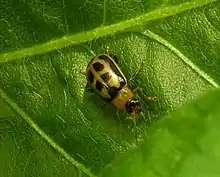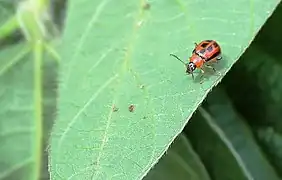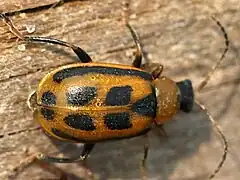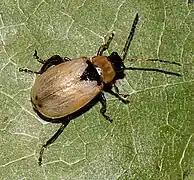Bean leaf beetle
Cerotoma trifurcata (also known as the bean leaf beetle)[1] is a species of beetle in the Chrysomelidae family that can be found in the Eastern and West United States.[2]
| Bean leaf beetle | |
|---|---|
 | |
| Scientific classification | |
| Domain: | Eukaryota |
| Kingdom: | Animalia |
| Phylum: | Arthropoda |
| Class: | Insecta |
| Order: | Coleoptera |
| Infraorder: | Cucujiformia |
| Family: | Chrysomelidae |
| Genus: | Cerotoma |
| Species: | C. trifurcata |
| Binomial name | |
| Cerotoma trifurcata (Forster, 1771) | |
| Synonyms | |
| |
Description
Adult beetles are 3.5–5.5 millimeters (0.14–0.22 in) in length, and have a punctated elytron at their posterior region. Morphs can have colors ranging from light gray to shades of yellow, brown, orange, or red. The elytra has a black triangle in the middle behind the thorax and typically has six additional black spots with a black band around the edges, though non-spotted morphs also occur.[3] The head is always black.[4]
 red morph
red morph brown morph
brown morph spotless morph
spotless morph
Habitat and ecology
The beetle feeds mostly on vegetables that are in the cotyledon-stage, such as cucumbers, cucurbits, pumpkin, and squash.[5] It also can be a pest of legumes such as soybean.[6][7][3] In early spring, adult beetles emerge to feed on legumes, such as alfalfa, before crops such as soybeans and green beans are available.[8]
Multiple generations occur per year depending on growing season length with one generation in northern climates, such as Ontario, one to two generations in the Upper Midwest US, and three generations in the southeastern US.[8]
Bean leaf beetle mostly overwinters in woodlot leaf litter, but can also be found in crop fields under soybean debris. Significant mortality can occur below 14 °F (−10 °C)[8]
Feeding
Larvae feed in the soil on plant roots, while adults consume vegetative tissue on host plants. Bean leaf beetle can also transmit bean pod mottle virus to beans through feeding. Feeding can significantly affect crop yield in some cases, although such damage is highly dependent on beetle densities in a field. Insecticides, such as pyrethroids, and delayed planting dates have been used to manage bean leaf beetle populations, but conditions when such measures are effective vary. Insecticidal seed treatments alone do not increase yield in areas prone to bean leaf beetle feeding or virus transmission. [8]
References
- Common name
- Distribution
- Krupke, Christian. "Bean Leaf Beetle". extension.entm.purdue.edu. Purdue. Retrieved 17 September 2017.
- Description Archived November 25, 2010, at the Wayback Machine
- R L Koch; E C Burkness; W D Hutchison. "Cerotoma trifurcata". Confirmation of bean leaf beetle, Cerotoma trifurcata, feeding on cucurbits. University of Arizona Library. Retrieved April 14, 2012.
- Legume consumption
- "Bean leaf beetles in Minnesota soybean : Soybean Production : University of Minnesota Extension". www.extension.umn.edu. Archived from the original on 18 September 2017. Retrieved 17 September 2017.
- "Bean leaf beetle". www.ent.iastate.edu. Retrieved 18 August 2019.